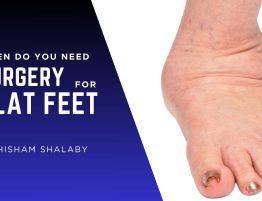
What are the success rates of ankle replacement surgery?
In terms of the success of the operation, one needs to define what success means in this context as there are certain objectives we have when performing ankle joint replacement surgery.
The first objective is to improve the patient’s pain and the procedure is usually very good at achieving this aim because the source of the pain, the actual arthritic ankle, is replaced.
A second clear objective, in some cases, is to correct the alignment of the joint as some patients have malalignment of their ankles. Ankle replacement is usually very good at correcting this because we work at length to get the alignment right with pre-operative navigation and intra-operative use of image intensifying machinery.
Another objective relates to the range of movement in the ankle. Post-surgery, a patient’s range of movement following ankle replacement surgery is variable, in that some people get a lot of movement and others get a little. Nonetheless, patients are happy with their results because their pain is much better.
For this reason, we explain to patients that ankle replacement surgery aims to address their pain and so any improvements in range of movement are an extra bonus. Naturally, we also have protocols for rehabilitation which we use in conjunction with physiotherapists to achieve as much range of movement as possible post-operatively.
In general, I tend to tell my patients that operations do not bring back normal ankles but they do fix ankle problems very well. So, if a patient has clear expectations and they are well informed about the operation, they are usually very happy after an ankle replacement.
When is an ankle joint replacement required?
Total ankle replacement is a surgical option offered to patients with end stage arthritis in the ankle joint. The other common surgical option is an ankle joint fusion.
Ankle replacement is generally offered to the older population. There is no specific cut-off age for this type of surgery but the idea of offering it to a slightly older generation is that the physical demand will be less and therefore that will maybe translate into a better survival of the implant.
The problem that we face with ankle arthritis, compared to hip and knee arthritis, is that most of our patients (seventy per cent of ankle arthritis patients) develop the conditionpost-traumatically (secondary to an injury), so these tend to be within a younger population. In fact, ankle osteoarthritis patients are generally twelve to fifteen years younger than hip or knee osteoarthritis patients.
There are certain contra-indications to ankle replacement. The absolute contra-indication is active infection but the other relative contra-indications are things like deficiency in the soft tissues, or the deficiency in the bone stock around the ankle joint, severe deformities or ankle instability. Nowadays ankle replacement is offered to more patients and is becoming more commonly accepted as a gold standard treatment for advanced ankle arthritis.
How long do ankle replacements last?
Ankle replacement has been around for decades. The first surgeries of this type were performed in the early 1970s but around the 1990s, ankle replacement turned a corner. At that point, designs improved, implants became much more conservative (meaning that less bone has to be taken out when the implant is put in place), we had better instrumentation, and the implants generally respected the anatomy of the patients much more.
The implants that we use nowadays are significantly better. We are now using the fourth generation of ankle replacements and they are extremely precise. They deploy the latest technologies like pre-operative computer navigation, for example. This allows us to access 3D computer models of the actual ankle that we are going to operate on, meaning we can simulate the surgery including where the implant will be placed exactly, so this makes positioning very accurate.
There has also been a significant improvement in other areas, including a much wider spectrum of designs. We now have implant designs to suit different types of patients, including options that will allow us to revise an ankle replacement that has previously failed.
The long term results (survival of the implant) of the third generation were better than ninety per cent at ten years, meaning that only one out of ten patients needed something done to their ankles within the decade following their procedure. With the implants that we are using now, the fourth generation, the results should be much better. At the moment, the two-year survival of these implants is much higher than ninety-eight per cent. In general, a well-executed ankle replacement in the right patient should last for years.





